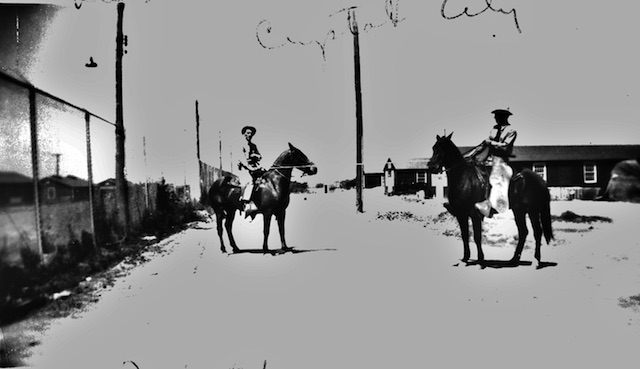
© unknownThe Crystal City Internment Camp in World War II.
The general history of America's internment of its own citizens during World War II has focused on the incarceration of 120,000 Japanese, 62 percent of them American-born, who were forcibly evacuated from the Pacific coast after the bombing of Pearl Harbor.
But few people know that Executive Order 9066, signed by President Roosevelt, which permitted the roundup of Japanese and their American-born children, also paved the way for the arrest of Germans and Italians who the FBI considered security risks and labeled as "enemy aliens." Indeed the day before Roosevelt signed the order FBI agents had arrested 264 Italians, 1,296 Germans, and 2,209 on the East and West Coast. The hunt for perceived enemies was on.
Here are five surprising facts about the extent of FDR's internment program:
Fact One: The arrests of suspected enemies extended far beyond our national borders. Under provisions of the Enemy Alien Act of 1798,
the same act that allowed Presidents George W. Bush and President Obama to intern modern-day suspected terrorists, Roosevelt orchestrated the removal of 4,058 Germans, 2,264 Japanese and 288 Italians from thirteen Latin American countries - and locked them up around the United States, many in a secret government internment camp located in Crystal City, Texas, an isolated desert town located at the southern tip of Texas, only thirty miles from the Mexican border. His reason? Roosevelt feared security threats from Germans and Japanese in Latin America.
Fact Two: Incredibly, among those taken from Latin America included a small number of Jews who had fled persecution in Germany. In his book,
Nazis and Good Neighbors, Max Paul Friedman documented 81 Jews in Latin America who were part of the roundup. One Jewish family - the Jacobis from Columbia - was interned in the camp in Crystal City.
Fact Three: The entire political and military establishment applied pressure on Roosevelt to pursue a vigorous internment policy. The only person close to him who opposed it was Eleanor Roosevelt who believed the case against immigrants was driven by wartime hysteria. "These people were not convicted of any crime but emotions ran too high, too many people wanted to wreak vengeance on Oriental looking people," she wrote of the evacuation order for the Japanese.
Shortly after the attack on Pearl Harbor, Roosevelt told Attorney General Francis Biddle to arrest Italians and Germans. "I don't care so much about the Italians. They are a lot of opera singers, but the Germans are different: they may be dangerous." In response, Biddle widened the net of suspicion.
Fact Four: One reason for the internment program was to create a pool of people of hostages to exchange for Americans trapped behind enemy lines in Europe and in the Pacific. FDR created a secret division within the Department of State called the Special War Problems Division, which negotiated numerous prisoner exchanges with Japan and Germany.
Fact Five: The Crystal City Internment Camp was at the center of those exchanges. Some former internees, who were children in the camp, refer to it as The Kidnap Camp. Thousands of internees in Crystal City, including their American-born children, were exchanged for ostensibly more important Americans - diplomats, businessmen, soldiers, physicians, and missionaries - behind enemy lines in Japan and Germany.
The first of four exchanges in Crystal City took place in June 1942 and the second
on September 2, 1943. During those exchanges, more than 2000 Japanese and Japanese Americans were traded for Americans caught in Japan. In February 1944, 634 German immigrants and their children, were sent from Crystal City into Germany. On
January 2, 1945, 428 more in Crystal City were traded into war.
The tableau of today's headlines about government surveillance, internment and prisoner exchanges was written more than seventy years ago in Crystal City, Texas.
Perhaps this doesn't fit your theme, but the Aleuts were also taken from their homes and kept in camps for the duration of the war.